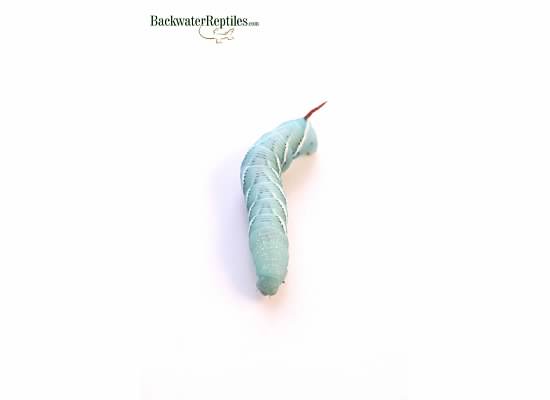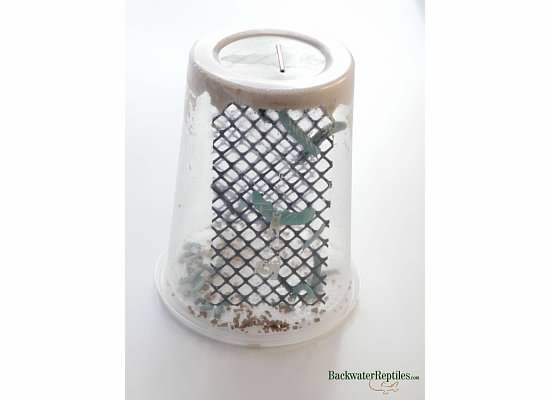Tobacco Hornworms (Manduca sexta), or Goliath worms, are caterpillars that transform into the Carolina sphinx moth. They are green with seven diagonal markings along their sides and a red, spiked “tail” adorning their rear ends, which is where they get their common name.
These caterpillars, which are more commonly known as just plain ol’ hornworms, feed on both tobacco and tomato plants, which means they are widely considered to be pests by farmers and gardeners.
Hornworms make excellent and nutritious meals for many animals sold through Backwater Reptiles, but many people don’t know much about these juicy little feeder insects.
In this article, we will answer the questions:
-What types of animals eat hornworms?
-How do I care for my feeder hornworms?
-What is the nutritional value of hornworms?
-What is the difference between the two species of hornworms?

What types of animals eat hornworms?
Hornworms are great feeder insects for virtually all types of reptiles, amphibians, and invertebrates including, but not limited to, turtles, frogs, scorpions, spiders, and lizards.
When you receive them, your hornworms will not be full-grown. At this smaller size, they can be fed to smaller animals or juvenile animals.
Once they have grown a bit and plumped up, your hornworms will be especially great feeders for animals that live in dry, arid environments where getting water from food is a requirement. Examples of these types of desert species that love to eat hornworms are: uromastyx lizards, collared lizards, agamas, tarantulas, and even scorpions.
Chameleons are also big fans of hornworms. We can’t stress enough that hornworms contain lots of water, so they are great to help your chameleon stay hydrated.
How do I care for my feeder hornworms?
When you place an order for feeder hornworms, you will receive a container that holds caterpillars that are either one inch or two to three inches long, depending on what option you select when you checkout.
Your hornworm pod will contain food for the hornworms on the top. It will also contain a screen for the hornworms to climb on to reach the food. The food will sustain the worms until they reach about four inches in size. This will usually take two to three weeks.

The hornworms you receive are basically in their own little ecosystem. Your hornworms are self-contained and have everything they need to thrive for a few weeks. All you need to do is remove the bottom of the container and empty out the hornworm droppings every few days.
What is the nutritional value of hornworms?
Hornworms are very high in calcium so they make excellent nutritional supplements for animals that need regular vitamin dusting such as leopard geckos.
As previously mentioned, hornworms are very succulent and high in water content. This makes them excellent food items for desert critters.
They are also great food for animals that are finicky eaters. They are even good for enticing animals on “hunger strike” to eat once more. If you have a picky eater on your hands, we suggest giving hornworms a try.
What is the difference between the two species of hornworm?
There are actually two types of hornworm that appear very similar – the tomato hornworm and the tobacco hornworm. People commonly confuse and mistake the two.
The tobacco hornworm (Manduca sexta) is the type of hornworm sold by Backwater Reptiles. They differ from the tomato hornworm (Manduca quinquemaculata) slightly in physical appearance. Rather than diagonal lines on their sides like the tobacco hornworm, the tomato hornworm has “V” shaped markings. In addition, the tobacco hornworm’s tail spike is red, while the tomato hornworm’s tail spike is black.

Both species feed on the same plants in the wild and we do not recommend capturing wild hornworms of either species to feed to your reptiles. This is because tobacco hornworms are actually capable of collecting and storing the toxin found in the tobacco plant, which means they could be fatal if ingested by your pet. So if you don’t know the difference between the two caterpillars, we suggest avoiding wild-caught hornworms altogether.
Conclusion
Pretty much any reptile, amphibian, or invertebrate that is large enough to eat a hornworm will find it a tasty treat.
If you have a desert-dwelling critter, picky eater, or spoiled rotten pet reptile, Backwater Reptiles has feeder hornworms for sale. Order some today – your herp will thank you!
